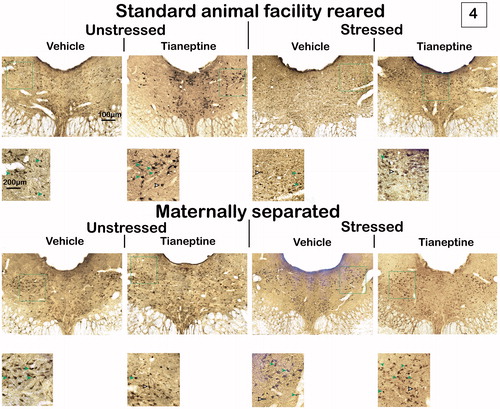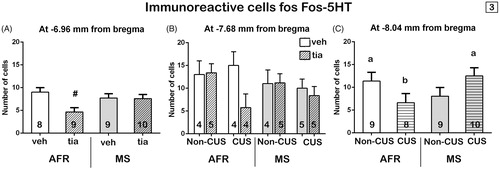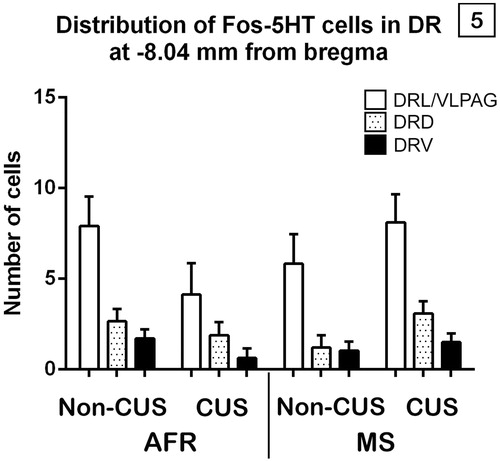Figures & data
Table 1. Chronic stress model.
Figure 1. Timeline of different protocols applied. AFR: Standard Animal Facility Reared; MS: maternal separated; PND: post natal day.

Figure 2. Dorsal raphe subdivisions. (A), at −6.96 mm from bregma; (B), At −7.68 mm from bregma and (C), at −8.04 mm from bregma. Aq, aqueduct; DRD, dorsal raphe dorsal; DRL, dorsal raphe lateral; DRV, dorsal raphe ventral.

Figure 3. Representative photomicrographs of Fos-5HT immunoreactivity within the DR at −8.04 mm from bregma of maternally separated, chronically stressed, and treated with tianeptine rats. Boxed areas indicate regions displayed at higher magnification below and in the left of each photo. White arrows indicate 5HT immunolabeled cells and green arrows indicate double immunolabeled cells for Fos and 5HT.

Figure 4. Effects of maternal separation (MS), chronic unpredictable stress (CUS) and tianeptine (tia) on Fos-5HT immunoreactivity within the DR at three rostrocaudal levels. Values are mean ± SEM of standard animal facility rearing (AFR) and maternally separated rats submitted to chronic stress or unstressed (Non-CUS) under tianeptine or vehicle (veh) treatment. The number of rats for each treatment is included inside each bar. (A) Immunoreactive cells for Fos-5HT at −6.96 mm from bregma. ANOVA revealed a significant maternal separation X drug interaction, #p < .05 versus the other groups, LSD post hoc test. (B) Immunoreactive cells for Fos-5HT at −7.68 mm from bregma. No significant effect or interaction was found. (C) Immunoreactive cells for Fos-5HT at −8.04 mm from bregma. Repeated measures revealed a significant maternal separation X chronic stress interaction. Different letters indicate significant differences between groups (p < .05), LSD post hoc test.

Figure 5. Effects of maternal separation (MS) and chronic unpredictable stress (CUS) on Fos-5HT immunoreactivity according to each subdivision within the dorsal raphe at −8.04 mm from bregma. Values are mean ± SEM of standard animal facility rearing (AFR) and maternally separated rats submitted to chronic stress or unstressed (Non-CUS). Repeated measures revealed a significant maternal separation X chronic stress interaction and a subdivision main effect.

